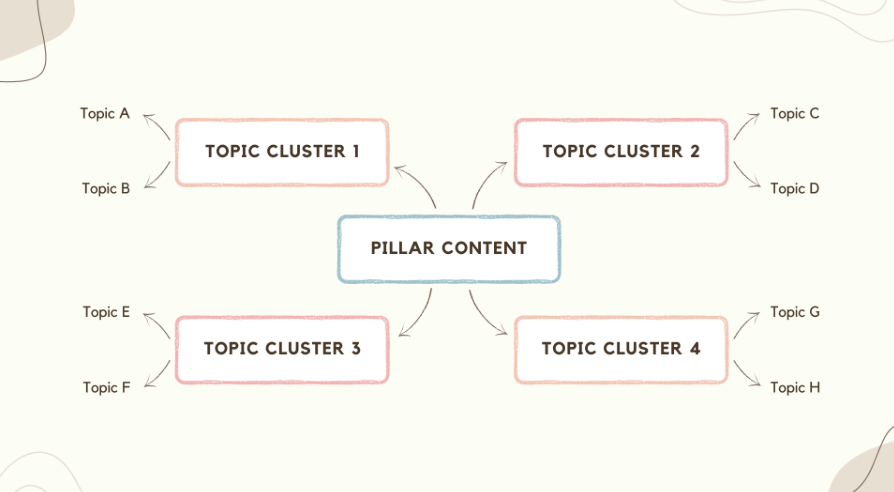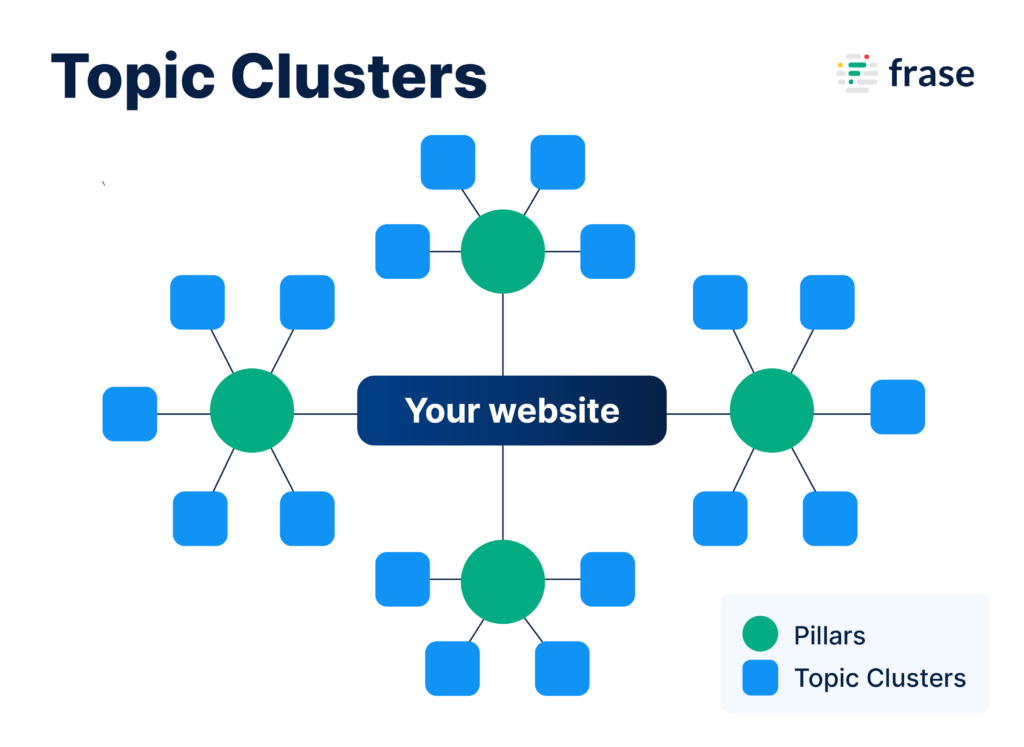
Analytica House
Tem 31, 2023Konu Kümeleme, Temel İçerik Stratejisi

Arama motoru optimizasyonu (SEO) dünyası yıllar içinde kayda değer bir evrim geçirdi. Geçmişte SEO stratejileri büyük ölçüde “anahtar kelime odaklı”ydı; belirli arama terimlerini bulup içeriğe bolca serpiştirmek yeterli sayılırdı. Ancak arama motoru algoritmaları geliştikçe, odak tek tek anahtar kelimelerden daha geniş, bütünsel bir “konu odaklı” yaklaşıma kaydı; genellikle “konu kümeleri” olarak adlandırılan bu yöntem, ilgili içerikleri tek bir ana tema etrafında organize etmeyi öne çıkarır.
“Konu kümeleri SEO”ya geçiş; ilgili içeriği bir “ana içerik” ya da “pillar content” etrafında toplamak anlamına gelir. Ana içerik, geniş bir konuda kapsamlı bir rehber veya genel bakış sunar ve bu içeriğe bağlı, daha spesifik birçok alt makale “küme içeriği” olarak işlev görür.
“Konu kümesi nedir?” diye merak ediyorsanız, basitçe konulara anahtar kelimelerden daha fazla öncelik veren bir modeldir. Anahtar kelimeler hâlâ önemini korurken, bu “SEO küme” yaklaşımı kullanıcılara belirli bir konu hakkında mantıksal ve yapılandırılmış bir bilgi ağı sunar, böylece arama niyetini daha eksiksiz karşılar.
Örnek vermek gerekirse, dijital pazarlama üzerine kapsamlı bir rehber düşünün; bu sizin ana içeriğiniz olur. SEO, içerik pazarlaması, sosyal medya pazarlaması gibi daha spesifik makaleler ise bu ana içeriğe geri bağlantı vererek küme içeriğini oluşturur.
Konu Kümelerini Anlamak
Dijital dünya geliştikçe, arama motoru algoritmalarının da karmaşıklığı artıyor ve kullanıcı odaklı, yapılandırılmış içerik üretimi gerektiriyor. İşte “konu kümeleri” – SEO ve içerik pazarlamasında devrim yaratan bir strateji.

Kaynak: Ahrefs
Konu kümeleri, ilgili içerik parçalarını bir araya getirerek bir konuyu kapsamlı biçimde ele almak demektir. Bu model, içeriklerinizin her birini izole bir birim olarak değil, birbirine bağlı bir ağ olarak sunar. Böylece hem arama motorlarına semantik bir yapı sunar hem de kullanıcı deneyimini geliştirir; ziyaretçiler aradıkları bilgiye kolayca ulaşır. Devam eden bölümlerde konu kümelerinin detaylarına, önemine ve modern dijital stratejilerde nasıl uygulandığına daha yakından bakacağız.
Konu Kümeleri Nedir?
Konu kümesi, bir web sitesindeki ilgili içerikleri düzenleme ve birbirine bağlama yöntemidir. Modelin merkezinde, belirli bir konunun genel bakışını sunan bir “pillar” sayfa bulunur. Bu ana içerik, o geniş konu altında yer alan daha derinlemesine makalelere (küme içeriği) bağlantı verir. Her bir küme içeriği, ana sayfada ele alınan alt başlıkları detaylandırır. Tüm küme sayfaları ana içeriğe geri bağlantı verir; böylece belirli bir konu hakkında kapsamlı, birbirine bağlı bir bilgi ağı oluşturulur.
Konu kümelerinin önemi birkaç başlıkta özetlenebilir:
- Geliştirilmiş Kullanıcı Deneyimi: İlgili içerikler gruplanarak kullanıcıların belirli bir konuda bilgi bulmasını kolaylaştırır. Bu yapı, derinlemesine bilgi sunarken site içinde geçirilen süreyi uzatır ve dönüşüm oranlarını yükseltebilir.
- Geliştirilmiş SEO: Konu kümeleri, arama motorlarına sitenizin belirli bir konuda otorite ve derin bilgi sunduğunu gösterir. Ana içerik ile küme içerikleri arasındaki semantik ilişki, arama motorlarının bağlamı ve alaka düzeyini daha iyi anlamasını sağlar, bu da sıralamanızı iyileştirebilir.
- Stratejik İçerik Planlaması: Konu kümesi modeli, mevcut içeriklerinizdeki boşlukları belirlemenize ve yeni, ilgili alt konular keşfetmenize yardımcı olur.
Konu Kümeleri ve Site Mimarisi
Konu kümesi stratejisi, site mimarisini de doğal olarak iyileştirir. Geleneksel yapıda sayfalar çoğunlukla birbirinden bağımsızdır ve arama motoru tarayıcılarının içerikler arasındaki ilişkileri kavramasını zorlaştırır. Konu kümeleri modelinde, ilgili içeriklerin birbirine bağlanması, arama motorlarının sitenizi daha verimli taramasını ve dizine eklemesini sağlar.

Kaynak: Frase
Arama motoru botları bir siteyi tararken sayfalar arasındaki bağlantıları izler. Ana içerik ve küme sayfalarını birbirine bağlayarak, botların tek bir ziyarette tüm ilgili içeriği keşfetmesini sağlarsınız. Bu verimli tarama, arama motorlarının sitenizdeki konu derinliğini ve genişliğini anlamasını kolaylaştırır ve SERP’lerde görünürlüğünüzü artırır.
Ayrıca konu kümeleri, bağlantı otoritesinin site genelinde dağıtılmasına yardımcı olur. Küme sayfası backlink aldığında, bağlı olduğu ana içerik de bu otoriteden faydalanır; böylece her iki sayfanın da SEO performansı yükselir.
Konu Kümesi Kontrol Listesi
Dijital içerik alanı geniştir ve otorite oluşturmak isteyen markalar için yapılandırılmış bir yaklaşım şarttır. Konu kümeleri bu yaklaşımın merkezindedir, içeriklerin hem kullanıcı odaklı hem de arama motoru beklentileriyle uyumlu olmasını sağlar. İşte stratejinizi ve uygulamanızı yönlendirecek bir kontrol listesi:
- Ana Konuyu Belirleyin: Nişinizle ilgili geniş bir konu seçin. Kitlenizin ilgisini gösterdiği ve derinlemesine alt konular üretebileceğiniz bir başlık olmalı. Google Trends, anahtar kelime araçları ve sosyal medya bu konuda yardımcı olabilir.
- Alt Konuları Fikir Aşamasında Belirleyin: Ana konu belirlendikten sonra bu başlık altında yer alacak daha spesifik alt konuları listeleyin. Örneğin “Dijital Pazarlama” ana konunuzsa, “SEO”, “İçerik Pazarlaması”, “Sosyal Medya Pazarlaması” alt konular olabilir.
- Anahtar Kelime Araştırması: Ana konu ve alt konular için anahtar kelime araştırması yapın. İçeriklerinizin hedef kitlenizin gerçekten aradığı terimlerle uyumlu olması kritik. Hacmi yüksek, rekabeti düşük terimleri belirleyerek sıralama şansınızı artırın.
- İçerik Oluşturma: Ana konu için kapsamlı bir “pillar” sayfa ve her alt konu için derinlemesine makaleler hazırlayın. Ana içerik genel bakış sunmalı, alt konular ise belirli yönleri detaylandırmalıdır. İçeriklerinizin kaliteli, ilgi çekici ve değer odaklı olmasına dikkat edin.
- Dahili Bağlantı Kurma: Ana içerik ve alt konular yayına alındıktan sonra aralarında bağlantılar oluşturun. Her alt konu sayfası ana içeriğe, ana içerik de alt konu sayfalarına link vermeli. Bu ağ, sayfalar arasındaki ilişkiyi güçlendirir ve SEO’yu iyileştirir.
- Optimizasyon: Her sayfanın SEO’ya tam uyumlu olduğundan emin olun. Anahtar kelimeleri başlık etiketinde, meta açıklamasında, URL’de ve içerikte kullanın. Mobil uyumluluk, sayfa hızı ve görsel optimizasyonu gibi faktörleri de göz önünde bulundurun.
- Kullanıcı Deneyimi: İçeriklerinizin kolay gezinilebilir olmasını sağlayın. Net başlıklar, okunabilir fontlar ve mantıksal navigasyon kullanın. İçeriklerin mobil uyumlu olduğundan emin olun; çünkü kullanıcıların çoğu mobil cihazlardan erişim sağlıyor.
İleriye Bakış
Dijital görünürlük dansında, paylaştığımız stratejileri uygulamak sizi sahnenin lideri yapabilir. Ancak SEO statik değildir. Teknoloji ve kullanıcı davranışları geliştikçe, yeni yöntemler de ortaya çıkacaktır. Yapay zeka, sesli arama ve artırılmış gerçeklik gibi gelişmeler; geleceğin SEO dünyasını şekillendirecek. Bu sürekli değişim, SEO’yu hem zorlu hem de heyecan verici kılıyor. Güncel kalmak, adapte olmak ve proaktif stratejiler geliştirmek hayati önem taşıyor. Bu değişimleri kucaklayın, en yeni bilgileri benimseyin ve dijital varlığınızın büyümesini izleyin.
Kaynaklar
More resources

Kullanıcı Deneyimi (UX) ve CRO İlişkisi
Dönüşüm oranlarını artırmak isteyen birçok ekip, reklam bütçesini yükseltmeye ya da yeni kampanyalar...

Yapay Zeka ile Müşteri Davranışlarını Saniyeler İçinde Nasıl Tahmin Ediyoruz?
E-ticaretin hareketli dünyasında her şirketin aklında sihirli bir soru vardır: "Hangi müşterim, ne z...

Okula Dönüş için E-Ticarette Hedefli Pazarlama Stratejileri
Okula dönüş kampanyalarında hedefli pazarlama, kullanıcı davranışlarını analiz ederek doğru e-ticare...

